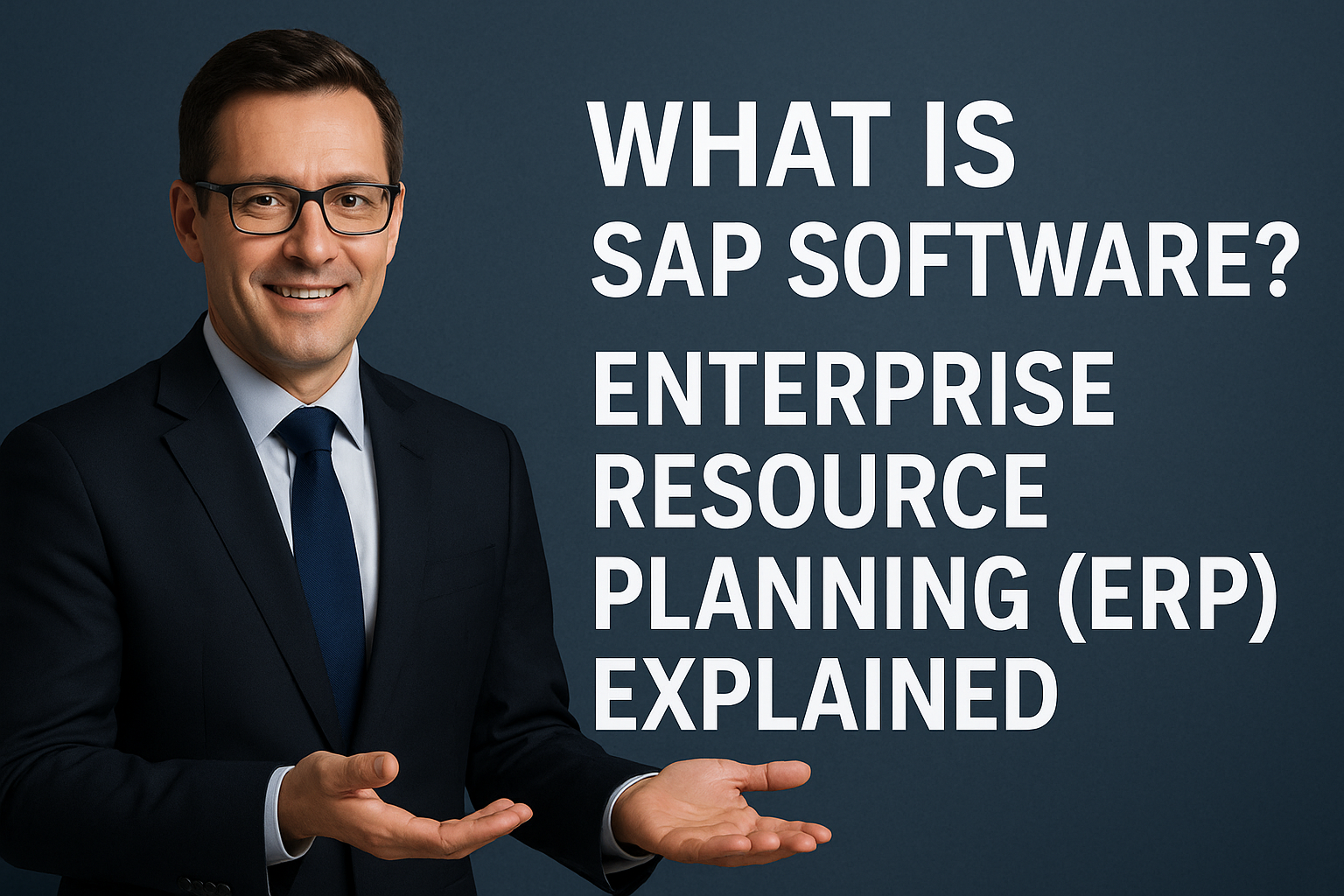In the complex tapestry of modern global business, where departments, data, and decisions are constantly in flux, there exists a critical need for a unifying force. This force acts as a central nervous system, connecting every limb and organ of an enterprise to ensure it moves with purpose, agility, and intelligence. That force, for a vast majority of the world’s largest and most successful organizations, is SAP software.
But what exactly is this ubiquitous platform that powers global commerce? This article provides a comprehensive exploration, answering the fundamental question, “What is SAP software?“ by delving into the world of Enterprise Resource Planning (ERP). We will journey through its history, core principles, modular architecture, tangible benefits, and its evolution into the intelligent, cloud-based suite it is today.
Part 1: The “What” and “Why” – Demystifying ERP
To truly understand SAP, one must first grasp the concept of Enterprise Resource Planning (ERP). Before ERP systems existed, businesses operated using a disjointed collection of software applications—often called “silos” or “islands of information.” The accounting department had its own software for managing ledgers, the sales team used a different system for tracking orders, the warehouse relied on a separate program for inventory, and HR managed payroll on yet another platform.
This fragmentation created significant problems:
Data Inconsistency: The sales system might show a product as “in stock,” while the warehouse inventory system, updated on a delay, knew it was sold out hours ago.
Inefficiency: Employees wasted time manually re-entering data from one system into another, a process prone to errors.
Poor Visibility: Executives struggled to get a unified, real-time view of the company’s health. Questions like “How profitable was that last big order once we factor in manufacturing and shipping costs?” were incredibly difficult and slow to answer.
ERP emerged as the solution. At its heart, an ERP system is a type of software that integrates all these disparate business processes into a single, unified system. It uses a common database, meaning every piece of information—from a customer’s name to a bolt’s price—is entered only once and becomes instantly available to every department that needs it, with appropriate security controls. This creates a “single source of truth” for the entire organization.
So, if ERP is the category, what is SAP software’s role? SAP is not just an ERP provider; it is the pioneer and, for decades, the undisputed market leader.
Part 2: The Genesis of a Giant – A Brief History of SAP
The story of SAP begins in 1972 in Mannheim, Germany. Five former IBM engineers—Dietmar Hopp, Hasso Plattner, Hans-Werner Hector, Klaus Tschira, and Claus Wellenreuther—had a visionary goal: to develop a standard software application that would process business data in real-time.
Their first product was called Systemanalyse und Programmentwicklung (“System Analysis and Program Development”), which later became the SAP R/1 system. The “R” stood for real-time. This was a revolutionary concept. Instead of batch processing, where transactions were collected and run overnight, R/1 allowed for immediate data processing. This breakthrough laid the foundation for everything that followed.
The company’s growth was fueled by successive generations of its software:
SAP R/2 (1979): This mainframe-based system became a powerhouse in multinational corporations, especially because of its robust handling of different languages and currencies.
SAP R/3 (1992): This was the game-changer. R/3 was built on a client-server architecture, which was more flexible and accessible than mainframes. Its modular design allowed companies to implement specific parts of the system (like Finance or Sales) as needed. The success of R/3 propelled SAP into a global software behemoth throughout the 1990s.
SAP ERP Central Component (ECC) – (2004s): The successor to R/3, SAP ECC became the backbone of thousands of enterprises worldwide. It is this version that most people think of when they refer to a classic “SAP implementation.”
This history is crucial because it explains SAP’s entrenched position. For over 30 years, large companies have built their digital infrastructure on SAP, making it deeply embedded in their operations.
Part 3: The Anatomy of SAP – Understanding its Modular Structure
One of the key strengths of SAP software is its modular design. Think of it as a set of interconnected Lego blocks, where each block represents a specific business function. These modules are designed to work together seamlessly but can also be implemented individually. The most common core modules include:
Financial Accounting (FI): The general ledger of the entire company. It manages all financial transactions, including accounts payable, accounts receivable, asset accounting, and more. It is the ultimate source of financial truth.
Controlling (CO): This module focuses on internal cost accounting and profitability analysis. While FI looks at external reporting, CO helps managers understand where money is being spent internally, by department, project, or product.
Sales and Distribution (SD): This module handles the entire sales process, from creating a quotation and sales order to managing pricing, shipping, and billing.
Materials Management (MM): This covers the entire supply chain within a company: purchasing, inventory management, warehouse management, and invoice verification.
Production Planning (PP): Designed for manufacturing companies, PP helps plan production schedules, manage capacity, and track the manufacturing process itself.
Human Capital Management (HCM): This module manages all HR processes, including payroll, recruitment, time management, and employee development.
The Magic of Integration: The real power is revealed when these modules interact. For example:
A salesperson creates an order in the SD module for 100 units of a product.
The system instantly checks the MM module for inventory. If stock is low, it can automatically trigger a purchase requisition.
Once the goods are produced (using the PP module) and shipped, the system generates an invoice.
This invoice data flows automatically to the FI module, updating accounts receivable.
The cost of sales and revenue from the order are simultaneously tracked in the CO module, allowing managers to see the profitability of that specific sale in real-time.
This seamless flow of information eliminates data redundancy and provides a holistic view of the business process from end to end.
Part 4: The Business Imperative – Why Do Companies Invest in SAP?
Implementing SAP is a massive undertaking, often costing millions of dollars and taking years to complete. So, why do companies commit to it? The benefits, while challenging to achieve, are transformative:
Operational Efficiency: By automating and integrating business processes, SAP drastically reduces manual data entry, minimizes errors, and speeds up workflows. This leads to lower operational costs and higher productivity.
Real-Time Data and Visibility: Executives and managers can see what is happening across the company at any given moment. They can generate reports that combine financial, sales, and operational data, leading to faster, more informed decision-making.
Scalability and Standardization: SAP is designed to grow with a business. A company can expand into new countries, acquire new subsidiaries, and add new product lines, and the SAP system can scale to support this growth. It also enforces standardized processes across the entire organization, which is crucial for large, multinational corporations.
Regulatory Compliance: Industries like pharmaceuticals, oil and gas, and banking are subject to strict regulations. SAP has built-in compliance features and audit trails that help companies meet these legal requirements more easily.
Improved Customer Service: With integrated data, customer service representatives have a 360-degree view of the customer. They can see order history, billing information, and previous interactions, enabling them to resolve issues quickly and effectively.
Part 5: The Modern Era – SAP’s Evolution to the Cloud (S/4HANA)
The business world has changed dramatically with the advent of cloud computing, big data, the Internet of Things (IoT), and AI. The traditional SAP ECC system, while powerful, was often seen as complex, expensive to maintain, and not built for the speed of the digital age.
SAP’s response to this shift was its most significant technological leap since R/3: SAP S/4HANA.
S/4HANA is SAP’s next-generation, intelligent ERP suite. It is not just an upgrade; it is a complete redesign built on several key pillars:
The HANA In-Memory Database: This is the foundation. Traditional databases store data on hard disks, which are slow to access. HANA stores all data in RAM (main memory), allowing for breathtaking processing speeds. Operations that used to take hours can now be completed in seconds.
A Simplified Data Model: HANA’s power allows SAP to eliminate redundant data aggregates and indices, simplifying the entire data structure and reducing the system’s footprint.
A New User Experience (SAP Fiori): S/4HANA introduces Fiori, a modern, intuitive, and role-based user interface. Unlike the complex, green-screen-like transactions of the past, Fiori offers a clean, web-based, and consumer-grade experience accessible on any device.
Embedded Analytics and Intelligence: Unlike ECC, where advanced analytics were often a separate process, S/4HANA has analytics built directly into the core transactions. It also incorporates AI and machine learning to offer predictive insights and automate routine tasks.
Cloud-First Approach: While S/4HANA can run on-premise, SAP is heavily promoting its cloud versions (public, private, hybrid). The cloud offers lower total cost of ownership, faster innovation cycles (with quarterly updates), and greater flexibility.
The transition from ECC to S/4HANA is the dominant theme in the SAP world today, as companies embark on “digital transformation” journeys to modernize their core systems.
Part 6: The Ecosystem and Criticisms
No discussion about what is SAP software is complete without acknowledging its vast ecosystem and common challenges.
The Ecosystem: The scale of SAP has created an entire industry around it. This includes:
Implementation Partners: Global consulting firms like Accenture, Deloitte, and IBM, as well as specialized boutiques, that help companies install, configure, and customize SAP.
SAP Consultants: Highly paid professionals with deep expertise in specific SAP modules.
Training and Certification: A robust market for SAP education, with official certifications being highly valued in the job market.
Common Criticisms:
Cost: The software licensing, hardware, and implementation consultancy fees are extraordinarily high, making it prohibitive for small and mid-sized businesses without tailored solutions.
Complexity: SAP implementations are notoriously complex and can disrupt business operations if not managed perfectly. They require significant change management within the organization.
Perceived Rigidity: The drive for standardization can sometimes be seen as forcing companies into “SAP’s way” of doing business, potentially stifling unique, competitive processes.
Conclusion: More Than Software, A Business Philosophy
So, what is SAP software? It is far more than just lines of code. It is the operational backbone of the global economy. It is a comprehensive toolkit for integrating and managing complex business processes. It is a strategic platform for digital transformation in the age of intelligence.
From its humble beginnings as a real-time accounting system to the AI-powered, cloud-native suite that is S/4HANA, SAP has consistently evolved to meet the demands of enterprise. While the journey to a successful SAP implementation is demanding, the reward is a level of integration, efficiency, and insight that empowers organizations to run at their very best. Understanding what is SAP software is, therefore, fundamental to understanding how the modern business world operates. It is the invisible engine that keeps the gears of industry turning, ensuring that from the warehouse floor to the CFO’s office, everyone is working from the same page, driven by a single source of truth.







